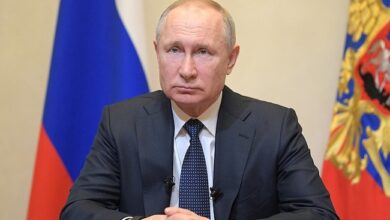The US & China are intensely competing to shape the outcome of World War C
While everyone was worried of what they believed would inevitably be World War III, mankind suddenly found itself fighting World War C against COVID-19 instead, which has since become the single most globally disruptive event in human history.

The entire world is at war, though it’s not one of the many World War III scenarios that a lot of people have speculated upon in the recent past (e.g. US vs. Iran, India vs. Pakistan, Russia vs. NATO, etc.), but a battle against an invisible foe that threatens us all and could theoretically infect every one of us without anyone else knowing until it’s too late. World War C, as the author has taken to calling it, is the single most globally disruptive event in human history because it occurred at the moment when the world was more connected than ever before through globalization. Life as we know it has been fundamentally changed in an instant and will never go back to how it was before, for better or for worse, and our final victory over this foe still seems too far away for comfort. There’s no telling when World War C will end, but it’s nevertheless already possible to prognosticate about how the system of International Relations is changing as the New Cold War of recent years takes a new form under these unexpected conditions.
The global competition between the US and China for predominant control over the world system isn’t going away, and will continue to characterize the coming decade, if not longer. The People’s Republic has already largely recovered from the initial onslaught of World War C that brought what many describe as “the world’s factory” to an abrupt standstill, thereby placing it in a comparatively more advantageous position to shape the outcome of this global conflict as the country shifts its focus from containing the virus at home to assisting others in this respect upon request after it obtained invaluable first-hand experience over the past few months. “China Is Saving The World From COVID-19“, as the author wrote earlier this week, but it won’t be the only savior if the US can help it. It’s true that China’s medical and humanitarian aid will greatly expand its soft power, the same as its foreseeable economic assistance will do once that phase of the Beijing-backed global recovery commences, but the US won’t willingly surrender its systemic hegemony without a fight.
That doesn’t mean that the US and China will enter into a kinetic (“shooting”) war with one another, but just that America will soon attempt to catch up to its competitor once it finally gets the situation at home under control. The first step to this effect can be seen through the de-facto imposition of martial law and historically unprecedented stimulus package that’s presently being negotiated, after which the US can then coordinate with its G7 allies to devise a solution for slowing down the West’s economic collapse. There should be no doubt that the fundamental basis of the global economy will forever change after what happened, though it’s thus far uncertain whether the new system will continue to be disproportionately influenced by the US or if China will succeed in more powerfully shaping the outcome. The “Trumpist” model is all about radical anti-globalization while China’s is closer to the previous system, as explained in the author’s piece last week titled “The Coronavirus: Crown Jewel Of The NWO Or Crippling Blow To Globalization?”
There are arguments in favor of either envisaged system coming out on top. World War C has exposed the fragility of global supply chains and the strategic risks of having other countries produce essential items such as medicine and related healthcare supplies, which works against China’s favor in the sense that its global Belt & Road Initiative (BRI) is all about doubling down on globalization, albeit with various reforms that Beijing believes will make this seemingly historically inevitable economic model more equitable for the Global South states that have hitherto largely been denied their fair share of its benefits. On the other hand, Trump can’t just snap his fingers and do away with decades of globalization considering the trillions of dollars of capital invested abroad over this period by the countless companies that offshored their production, especially since “the world’s factory” is already recovering and therefore able to rely on its pre-crisis physical assets to help the rest of the world as well, which could incentivize the recipients to preserve as much of the old system as possible.
World War C is the ultimate black swan event, one which might also give rise to other relatively less impactful but nevertheless still significant black swans as well, such as the outright collapse of major economies and so-called “fragile/failed states” alike, be it those in the EU or the Global South respectively. It’s these tangential consequences of this global conflict — and the degree to which the US and China can influence them, whether in terms of actualizing these scenarios or preventing them — that will prove to be the ultimate game-changers in this equation. At the risk of sounding cliche, there are “known unknowns” and “unknown unknowns”, and while strategists might be able to forecast some of the former and thus help their states better react to such possible challenges, their skills will really be put to the test rapidly responding to the latter the moment that they begin to arise. All that we regular folks can do without any “inside information” or the data needed to arrive at relevant conclusions is try to figure out what might prospectively constitute these two categories.
A “known unknown” might be the resiliency of the Iranian government as the country struggles to prevent the current confluence of crises from leading to regime change like the author wrote earlier in the month in his piece titled “Iran: Regime Change By Coronavirus?“. An “unknown unknown”, meanwhile, could be a latent social, economic, political, and/or religious trend that has thus far largely escaped detection but which might quickly come to the fore of worldwide attention, whether directly in the sense of shaping the emerging world order or indirectly by exercising disproportionate influence over a key player in this equation (or a comparatively less significant one which can in turn influence that said key player). It’s not hyperbole to say that World War C has opened up Pandora’s Box in every respect and that everyone should brace themselves for more rapid and unexpected changes, both in terms of how they live their lives and also just as importantly in the sense of the emerging world order’s formation.
As it stands, however (and barring an “unknown unknown” such as something that leads to the complete and irreversible collapse of the US and/or China), the one constant that can thus far arguably be relied upon is that the US and China will continue competing with one another per their ever-intensified New Cold War in order to shape the global systemic outcome of World War C. This is first and foremost a battle against the invisible enemy of COVID-19, but secondly, it’s also a battle between the American and Chinese models of global economics that in turn will form the basis upon which the subsequent international political system will be built once this conflict finally ends. Amidst all of this, there are countless latent risk to the author’s forecast that could abruptly shift the entire trajectory of every future scenario, though it’s of course too early to identify each and every one of them as they presently exist (provided that they’ve even been identified) given how fast everything is moving, but the present analysis should hopefully suffice for the time being at least.




